The 6 best spots on the Costa Blanca, chosen by locals
9 Feb 2018
Granted, there are places on the Costa Blanca where English and German are more likely to be the language of communication than Spanish. The white beaches entice so many tourists that sometimes it is drumming.
Of course you know Benidorm, the former fishing village that now houses the largest concentration of skyscrapers per square meter outside of New York. To get a half-square meter on the beach there during the high season, you have to rely on ellenbogen work that Marcin Wasilewski would be proud of.
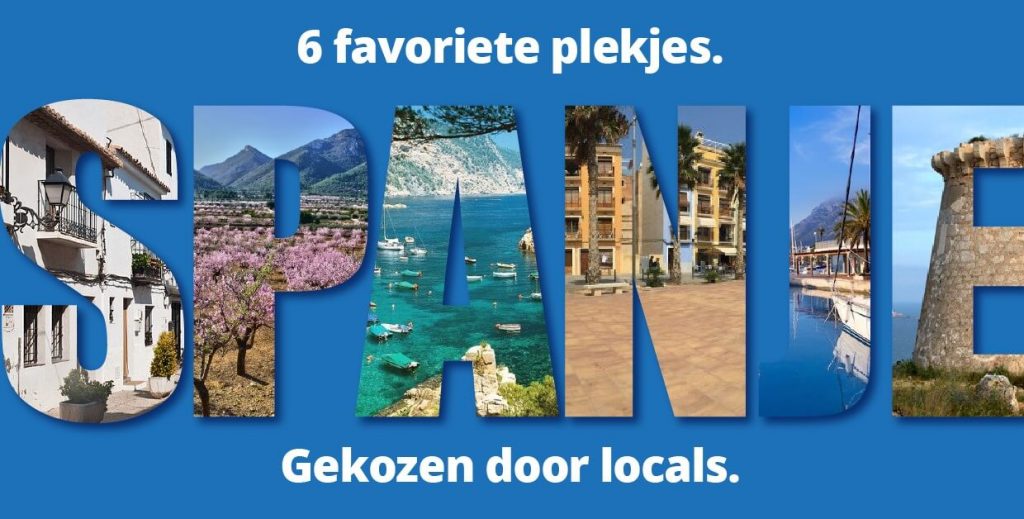
But even though the Costa Blanca is one of the most touristic places on earth, this Spanish coastal strip should not be synonymous with the scenario described above. There are also places where you won't be knocked over every five bones by a bomma in an electric wheelchair. Or where you don't have to be careful not to trip over a Brit drunk off the trail.
Yep, even on the Costa Blanca you can run away from the herds and find your own quiet place. We polled locals about their favorite spots on the Costa Blanca. This is the result.
1. Jávea
It is no wonder that artists fell and continue to fall in love en masse with this seaside resort near Calpe. The color of the water there is of an even more beautiful blue than elsewhere on the Costa Blanca! Playa de la Granadella in particular, a horseshoe bay surrounded by pine forests, charms everyone. This beach is often cited as the most beautiful in Spain. Here a lot of locals happily flatter themselves on a towel - so it can get quite crowded.
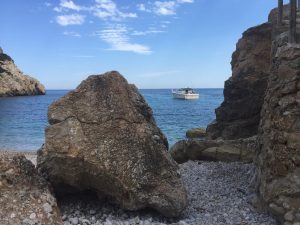
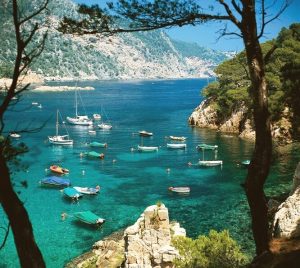
Unlike in Benidorm, there are no large skyscrapers lining the coastline of Jávea (or Xàbia in Valencian). More to the point, tall buildings are prohibited here. Get lost in the narrow alleys lined with ancient sandstone houses built on a hillside around the 15th-century Gothic fortress church of San Bartolome. Or sit on a terrace in Pueblo, the old town with its white houses, from where you can watch the fishermen bring in their catch.
In Jávea you can eat excellent food, for example at BonAmb, the restaurant of Spain's youngest Michelin-starred chef. Not that it always had to cost a lot of money: Jávea's restaurants and nightlife are of a high standard. Watching the oranges sunset with a cocktail or a
cerveza in your fists, you will quickly realize why Jávea was nicknamed the "pearl of the Costa Blanca.
2. Santa Pola
This is a small coastal village, tailor-made for vacationers who find the big resorts a bit too crowded. It has everything you need: beautiful beaches, a primitive city center and old fishing districts where time ticks slowly. The 16th-century watchtowers - from which pirates and other hoarders were watched - will capture the imagination of any history buff. Not to mention the Castillo Fortaleza - a veritable castle - and the ruins of the ancient Roman city.
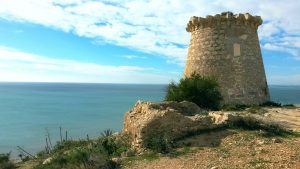
The town's anchor point - literally and figuratively - is the yacht and classic fishing port. From here, elongated promenades depart in both directions, where it is delightful to stroll during any season. The terraces along the promenade are a great place to relax with a newspaper and a cup of coffee, and the many restaurants serve delicious seafood for little money. The fact that many local Spaniards also come here to eat is the best indication of quality. And that you observed with your own eyes earlier that day how the catch arrived in port indicates freshness.
Santa Pola's location is excellent for day trips to Alicante, the salt lakes of Torrevieja or Tabarca, Spain's smallest inhabited island. There you can sometimes spot dolphins. Hikers, cyclists, birdwatchers, golfers, surfers: all get along just fine in and around Santa Pola.
3. Altea
This old town is a stone's throw from Benidorm, but it is a different world. This is by far one of the Costa Blanca's most charming villages - a maze of small cobbled streets where you can catch glimpses of the bay behind many a corner. Stroll in the neighborhood of Altea la Vella (old Altea) among the chapels and cypress trees and do not hesitate to speak to a
local - the people of Altea are known for their friendliness. The port area still has the look and feel of the old Spanish fishing villages.
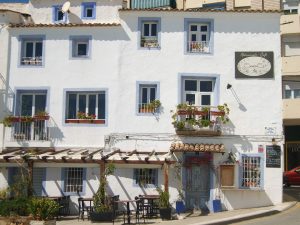
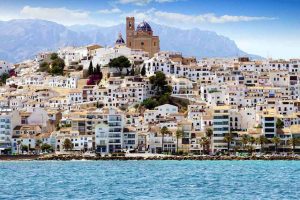
Like Jávea, Altea attracts many artistic types. The way the light falls, the historic buildings, the ancient city built against a mountain: for sculptors and painters, it was a breeze to bump into the muse here. Even today, many have studios there. Writers, poets and singers also enjoy coming to Altea.
Although even people without the slightest artistic fiber in their bodies can enjoy Altea. Good food, sailing or just relaxing - it's all among the possibilities. Altea lies along the busy route from Benidorm to Calpe, but its eight kilometers of beaches are usually not very crowded. In fact, they are not sandy beaches, but ones with small pebbles.
4. Jálon Valley
To discover the "real" Spain, you must head inland. Into the majestic mountains, through orchards of lemons, oranges and almonds. Away from the arid landscapes, welcome to the sleepy villages of the Jálon Valley.
[caption id="attachment_2042" align="aligncenter" width="300"]
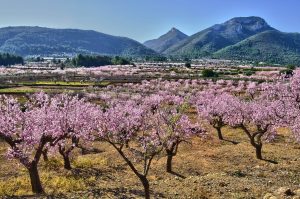
Almond trees in bloom in the Jalon Valley[/caption]
They are small villages with a square, a church tower and a tapas bar. Where time stands still, where the siesta is holier than the gospel and where local customs have not yet given way to those of the expats. In villages like this, old people in flat caps play dominoes in the streets, women hang laundry to dry on their balconies and local youth run after a soccer ball. The church bells there provide the only disturbance to the peace.
The Jálon Valley is known for viticulture. The great pride here is the Muscat grape. The Muscatel wine the locals make from it tastes great with regional dishes like sardines or stuffed tomatoes. Be sure to stop in the medieval village of Benissa, located along the winding coastal road between Valencia and Alicante.
5. Dénia
No skyscrapers here either, but there is an 18th-century honey-colored fortress called Castillo de Dénia. The history of this gem is rich - from the Romans over the Moors to today. That past has left many ruins in Dénia. Although, of course, sunbathers notice little of that: they are too busy exploring the 30 kilometers of Blue Flag beaches north of this Costa Blanca town. To the south there are mostly rocky coves, where there is good snorkeling.
[caption id="attachment_2041" align="aligncenter" width="300"]

The marina of Dénia.[/caption]
Spanish foodies come to Dénia from far and wide. Particularly for more than 300 top-class restaurants specializing mainly in rice dishes and the delicious local shrimp. In the restaurants, cocktails flow profusely. No wonder: nowhere in Spain are more fiestas celebrated than here. And considering the reputation of the Spanish party nerds, that means a lot.
The biggest party the
locals celebrate from June 22 to 24, the Hogueras de San Juan. With hundreds of life-size papier-mâché puppets, they make fun of politicians and celebrities. Feel free to compare it to the carnival in Aalst. At the end, the Spaniards set fire to the statues. Whereupon a big party ensued, curiously without too much satire. It is not long to wait for another celebration: in July it is prize again. A bull run ends on the beach, where the runners throw themselves into the sea.
6. Villajoyosa
According to one, Villajoyosa (La Vila Joiosa in Valencian) means the "happy" or "joyful" town. The other believes the city is "jewel-encrusted. We think ours. Why should one rule out the other? The fact is that Villajoyosa is one of the most picture-perfect spots on the Costa Blanca.
Here it is the colored fishermen's houses that attract attention and create a fairy-tale atmosphere. The story behind it makes it even more fun: fishermen painted their houses a bright color so they could easily see where they were supposed to sail to. The narrow alleys and stairways complete the picture.
[caption id="attachment_2046" align="aligncenter" width="300"]
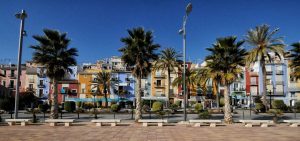
"Tiens, where did I live again?"[/caption]
Locals like to come here because the beaches are relatively quiet, especially compared to some others on the Costa Blanca. Or they come to snack on the "chocolate con churros," a kind of Spanish doughnut dipped in chocolate sauce. Villajoyosa is famous for its chocolate industry - in the past there were as many as 20 factories here. In short, as a Belgian, you will feel at home in this gem of a city in no time.
Living in Villajoyosa? Maybe a spot in the Blue Line Residence is for you, 65 top-notch apartments overlooking the Mediterranean. Any other preference? Please feel free to contact us and Gold Estates will be happy to think with you.
 But even though the Costa Blanca is one of the most touristic places on earth, this Spanish coastal strip should not be synonymous with the scenario described above. There are also places where you won't be knocked over every five bones by a bomma in an electric wheelchair. Or where you don't have to be careful not to trip over a Brit drunk off the trail.
Yep, even on the Costa Blanca you can run away from the herds and find your own quiet place. We polled locals about their favorite spots on the Costa Blanca. This is the result.
But even though the Costa Blanca is one of the most touristic places on earth, this Spanish coastal strip should not be synonymous with the scenario described above. There are also places where you won't be knocked over every five bones by a bomma in an electric wheelchair. Or where you don't have to be careful not to trip over a Brit drunk off the trail.
Yep, even on the Costa Blanca you can run away from the herds and find your own quiet place. We polled locals about their favorite spots on the Costa Blanca. This is the result.

 Unlike in Benidorm, there are no large skyscrapers lining the coastline of Jávea (or Xàbia in Valencian). More to the point, tall buildings are prohibited here. Get lost in the narrow alleys lined with ancient sandstone houses built on a hillside around the 15th-century Gothic fortress church of San Bartolome. Or sit on a terrace in Pueblo, the old town with its white houses, from where you can watch the fishermen bring in their catch.
In Jávea you can eat excellent food, for example at BonAmb, the restaurant of Spain's youngest Michelin-starred chef. Not that it always had to cost a lot of money: Jávea's restaurants and nightlife are of a high standard. Watching the oranges sunset with a cocktail or a cerveza in your fists, you will quickly realize why Jávea was nicknamed the "pearl of the Costa Blanca.
Unlike in Benidorm, there are no large skyscrapers lining the coastline of Jávea (or Xàbia in Valencian). More to the point, tall buildings are prohibited here. Get lost in the narrow alleys lined with ancient sandstone houses built on a hillside around the 15th-century Gothic fortress church of San Bartolome. Or sit on a terrace in Pueblo, the old town with its white houses, from where you can watch the fishermen bring in their catch.
In Jávea you can eat excellent food, for example at BonAmb, the restaurant of Spain's youngest Michelin-starred chef. Not that it always had to cost a lot of money: Jávea's restaurants and nightlife are of a high standard. Watching the oranges sunset with a cocktail or a cerveza in your fists, you will quickly realize why Jávea was nicknamed the "pearl of the Costa Blanca.
 The town's anchor point - literally and figuratively - is the yacht and classic fishing port. From here, elongated promenades depart in both directions, where it is delightful to stroll during any season. The terraces along the promenade are a great place to relax with a newspaper and a cup of coffee, and the many restaurants serve delicious seafood for little money. The fact that many local Spaniards also come here to eat is the best indication of quality. And that you observed with your own eyes earlier that day how the catch arrived in port indicates freshness.
Santa Pola's location is excellent for day trips to Alicante, the salt lakes of Torrevieja or Tabarca, Spain's smallest inhabited island. There you can sometimes spot dolphins. Hikers, cyclists, birdwatchers, golfers, surfers: all get along just fine in and around Santa Pola.
The town's anchor point - literally and figuratively - is the yacht and classic fishing port. From here, elongated promenades depart in both directions, where it is delightful to stroll during any season. The terraces along the promenade are a great place to relax with a newspaper and a cup of coffee, and the many restaurants serve delicious seafood for little money. The fact that many local Spaniards also come here to eat is the best indication of quality. And that you observed with your own eyes earlier that day how the catch arrived in port indicates freshness.
Santa Pola's location is excellent for day trips to Alicante, the salt lakes of Torrevieja or Tabarca, Spain's smallest inhabited island. There you can sometimes spot dolphins. Hikers, cyclists, birdwatchers, golfers, surfers: all get along just fine in and around Santa Pola.

 Like Jávea, Altea attracts many artistic types. The way the light falls, the historic buildings, the ancient city built against a mountain: for sculptors and painters, it was a breeze to bump into the muse here. Even today, many have studios there. Writers, poets and singers also enjoy coming to Altea.
Although even people without the slightest artistic fiber in their bodies can enjoy Altea. Good food, sailing or just relaxing - it's all among the possibilities. Altea lies along the busy route from Benidorm to Calpe, but its eight kilometers of beaches are usually not very crowded. In fact, they are not sandy beaches, but ones with small pebbles.
Like Jávea, Altea attracts many artistic types. The way the light falls, the historic buildings, the ancient city built against a mountain: for sculptors and painters, it was a breeze to bump into the muse here. Even today, many have studios there. Writers, poets and singers also enjoy coming to Altea.
Although even people without the slightest artistic fiber in their bodies can enjoy Altea. Good food, sailing or just relaxing - it's all among the possibilities. Altea lies along the busy route from Benidorm to Calpe, but its eight kilometers of beaches are usually not very crowded. In fact, they are not sandy beaches, but ones with small pebbles.
 Almond trees in bloom in the Jalon Valley[/caption]
They are small villages with a square, a church tower and a tapas bar. Where time stands still, where the siesta is holier than the gospel and where local customs have not yet given way to those of the expats. In villages like this, old people in flat caps play dominoes in the streets, women hang laundry to dry on their balconies and local youth run after a soccer ball. The church bells there provide the only disturbance to the peace.
The Jálon Valley is known for viticulture. The great pride here is the Muscat grape. The Muscatel wine the locals make from it tastes great with regional dishes like sardines or stuffed tomatoes. Be sure to stop in the medieval village of Benissa, located along the winding coastal road between Valencia and Alicante.
Almond trees in bloom in the Jalon Valley[/caption]
They are small villages with a square, a church tower and a tapas bar. Where time stands still, where the siesta is holier than the gospel and where local customs have not yet given way to those of the expats. In villages like this, old people in flat caps play dominoes in the streets, women hang laundry to dry on their balconies and local youth run after a soccer ball. The church bells there provide the only disturbance to the peace.
The Jálon Valley is known for viticulture. The great pride here is the Muscat grape. The Muscatel wine the locals make from it tastes great with regional dishes like sardines or stuffed tomatoes. Be sure to stop in the medieval village of Benissa, located along the winding coastal road between Valencia and Alicante.
 The marina of Dénia.[/caption]
Spanish foodies come to Dénia from far and wide. Particularly for more than 300 top-class restaurants specializing mainly in rice dishes and the delicious local shrimp. In the restaurants, cocktails flow profusely. No wonder: nowhere in Spain are more fiestas celebrated than here. And considering the reputation of the Spanish party nerds, that means a lot.
The biggest party the locals celebrate from June 22 to 24, the Hogueras de San Juan. With hundreds of life-size papier-mâché puppets, they make fun of politicians and celebrities. Feel free to compare it to the carnival in Aalst. At the end, the Spaniards set fire to the statues. Whereupon a big party ensued, curiously without too much satire. It is not long to wait for another celebration: in July it is prize again. A bull run ends on the beach, where the runners throw themselves into the sea.
The marina of Dénia.[/caption]
Spanish foodies come to Dénia from far and wide. Particularly for more than 300 top-class restaurants specializing mainly in rice dishes and the delicious local shrimp. In the restaurants, cocktails flow profusely. No wonder: nowhere in Spain are more fiestas celebrated than here. And considering the reputation of the Spanish party nerds, that means a lot.
The biggest party the locals celebrate from June 22 to 24, the Hogueras de San Juan. With hundreds of life-size papier-mâché puppets, they make fun of politicians and celebrities. Feel free to compare it to the carnival in Aalst. At the end, the Spaniards set fire to the statues. Whereupon a big party ensued, curiously without too much satire. It is not long to wait for another celebration: in July it is prize again. A bull run ends on the beach, where the runners throw themselves into the sea.
 "Tiens, where did I live again?"[/caption]
Locals like to come here because the beaches are relatively quiet, especially compared to some others on the Costa Blanca. Or they come to snack on the "chocolate con churros," a kind of Spanish doughnut dipped in chocolate sauce. Villajoyosa is famous for its chocolate industry - in the past there were as many as 20 factories here. In short, as a Belgian, you will feel at home in this gem of a city in no time.
Living in Villajoyosa? Maybe a spot in the Blue Line Residence is for you, 65 top-notch apartments overlooking the Mediterranean. Any other preference? Please feel free to contact us and Gold Estates will be happy to think with you.
"Tiens, where did I live again?"[/caption]
Locals like to come here because the beaches are relatively quiet, especially compared to some others on the Costa Blanca. Or they come to snack on the "chocolate con churros," a kind of Spanish doughnut dipped in chocolate sauce. Villajoyosa is famous for its chocolate industry - in the past there were as many as 20 factories here. In short, as a Belgian, you will feel at home in this gem of a city in no time.
Living in Villajoyosa? Maybe a spot in the Blue Line Residence is for you, 65 top-notch apartments overlooking the Mediterranean. Any other preference? Please feel free to contact us and Gold Estates will be happy to think with you.










